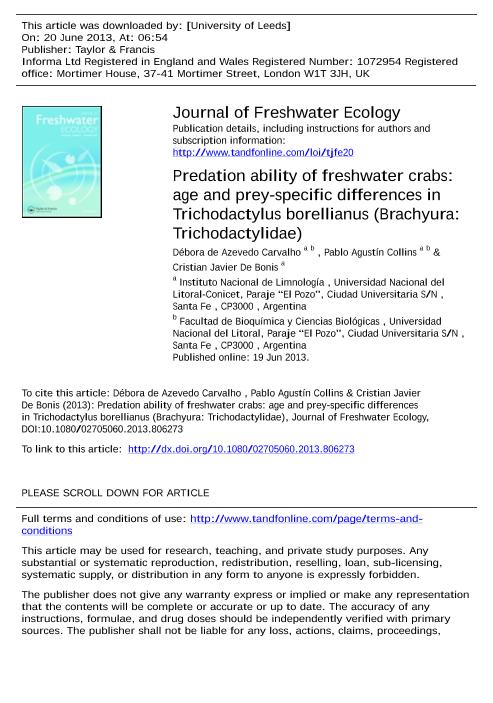Mostrar el registro sencillo del ítem
dc.contributor.author
de Azevedo Carvalho, Débora

dc.contributor.author
Collins, Pablo Agustin

dc.contributor.author
de Bonis, Cristian

dc.date.available
2017-08-15T14:39:26Z
dc.date.issued
2013-06
dc.identifier.citation
de Azevedo Carvalho, Débora; Collins, Pablo Agustin; de Bonis, Cristian; Predation ability of freshwater crabs: age and prey-specific differences in Trichodactylus borellianus (Brachyura: Trichodactylidae); Taylor & Francis; Journal Of Freshwater Ecology; 28; 4; 6-2013; 573-584
dc.identifier.issn
0270-5060
dc.identifier.uri
http://hdl.handle.net/11336/22434
dc.description.abstract
Freshwater crabs are rarely represented in food webs and their role in these ecosystems has been largely ignored. Trichodactylus borellianus is an omnivorous crab species that has a diverse natural trophic spectrum. This paper evaluates, in a laboratory assay, the ability of three ages of this crab to prey on three different organisms. The prey selectivity and relative importance of each prey item was also analyzed. Prey items (cladocerans, oligochaetes, and golden mussels) consisted of organisms of different shapes and mobility, representing the natural diet of this crab. Crabs were sorted according to size (juvenile, sub-adult, and adult) and increasing amounts of one prey was offered to each crab after 24 hrs of starvation. In the selectivity trial, all prey types were offered in a fixed set. Crabs in all three age categories were able to prey on all organisms. Cladocerans and oligochaetes were consumed in greater quantities compared to golden mussels when offered separately. However, only the consumption of oligochaetes exhibited a positive correlation with the crabs? size. When cladocerans and oligochaetes were offered together, more oligochaetes were consumed, both as percentage of volume and occurrence. Age-specific changes in consumption could be related to differences in the stomach capacity of the crab, the digestion time of each prey, and the predator?prey encounter probability. The selection of the most elongated prey with the lowest mobility indicated that the balance of the gain and loss of energy made it an advantageous species to prey on, as it was susceptible to predation. Additionally, the mussel, which is an invasive species, although not positively selected by T. borellianus in the present study, represented a new trophic resource for this crab.
dc.format
application/pdf
dc.language.iso
eng
dc.publisher
Taylor & Francis

dc.rights
info:eu-repo/semantics/openAccess
dc.rights.uri
https://creativecommons.org/licenses/by-nc-sa/2.5/ar/
dc.subject
Trichodactylidae
dc.subject
Freshwater Crabs
dc.subject
Prey Selection
dc.subject
Predation Capacity
dc.subject.classification
Bioquímica y Biología Molecular

dc.subject.classification
Ciencias Biológicas

dc.subject.classification
CIENCIAS NATURALES Y EXACTAS

dc.title
Predation ability of freshwater crabs: age and prey-specific differences in Trichodactylus borellianus (Brachyura: Trichodactylidae)
dc.type
info:eu-repo/semantics/article
dc.type
info:ar-repo/semantics/artículo
dc.type
info:eu-repo/semantics/publishedVersion
dc.date.updated
2017-07-28T16:25:46Z
dc.journal.volume
28
dc.journal.number
4
dc.journal.pagination
573-584
dc.journal.pais
Reino Unido

dc.journal.ciudad
Londres
dc.description.fil
Fil: de Azevedo Carvalho, Débora. Consejo Nacional de Investigaciones Científicas y Técnicas. Centro Científico Tecnológico Conicet - Santa Fe. Instituto Nacional de Limnología. Universidad Nacional del Litoral. Instituto Nacional de Limnología; Argentina
dc.description.fil
Fil: Collins, Pablo Agustin. Consejo Nacional de Investigaciones Científicas y Técnicas. Centro Científico Tecnológico Conicet - Santa Fe. Instituto Nacional de Limnología. Universidad Nacional del Litoral. Instituto Nacional de Limnología; Argentina
dc.description.fil
Fil: de Bonis, Cristian. Consejo Nacional de Investigaciones Científicas y Técnicas. Centro Científico Tecnológico Conicet - Santa Fe. Instituto Nacional de Limnología. Universidad Nacional del Litoral. Instituto Nacional de Limnología; Argentina
dc.journal.title
Journal Of Freshwater Ecology

dc.relation.alternativeid
info:eu-repo/semantics/altIdentifier/doi/http://dx.doi.org/10.1080/02705060.2013.806273
dc.relation.alternativeid
info:eu-repo/semantics/altIdentifier/url/http://www.tandfonline.com/doi/abs/10.1080/02705060.2013.806273
Archivos asociados
